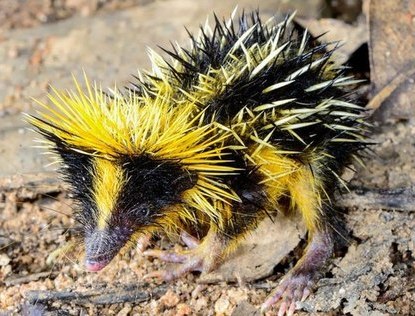
Lowland streaked tenrec(Hemicentetes semispinosus)
Phylum —chordata
Class — mammalia
Order — afrosoricida
Family — tenrecidae
Genus—hemicentetes
Appearance
The average body size is a length of 140 mm (5.5 in) however adults have been recorded to grow up to a maximum of 172 mm (6.8 in). Body weight for adults of this species can range from 125–280 g (4.4–9.9 oz).
This species has a black spiny pelage with yellow or chestnut-brown stripes that run the length of the body. There is a median yellow stripe that runs down the rostrum along with one dorsal and two lateral stripes that mark the length of the body and may serve as a warning to predators. Quills are present in this species being longer and more numerous on the head and nuchal area. However, the ventral region contains few to no quills but have the ability to detach in predation defense.
Habitat
The natural range of these animals covers the eastern parts of Madagascar, where they inhabit scrubland as well as lowland and mid-altitude rainforests.
Behavior
The Lowland streaked tenrec is the only sociable tenrec species, gathering into groups. Groups of these tenrecs are family units, consisting of up to 20 animals. These diurnal animals can forage both solitarily and in small groups. During the winter months they conserve heat by reducing their body temperature to that of the air, meanwhile remaining active. However, when it gets too cold, they usually undergo periods of hibernation. Nesting sites of Lowland tenrecs are located near water, in fixed burrows. Their latrine sites are hidden in leaves and are typically situated near the entrance of the nest. Members of a group dig burrows, which are connected between each other, forming a complex burrow system, belonging to one group. Group members communicate through stridulating special quills. When threatened, tenrecs raise the quills, surrounding their neck. If threatened, they usually try to prickle the opponent with their quills, accompanying it with violent bucking of their head.
Diet
The diet of these vermivorous or worm-eating animals primarily consists of earthworms, supplemented with various insects.
Reproduction
Little is known about the reproductive system of this species. It's known that, during the mating season, males compete with each other, engaging in fights in order to attract the attention of receptive females. Lowland tenrecs mate in September-December. Gestation period lasts for 55-63 days, yielding 2-11 young with an average of 5-8 per litter. Male Lowland tenrecs are careful to young. Weaning occurs at 18-25 days old. Females of this species reach sexual maturity as early as 25 days old, being the only tenrecs that begin breeding during the same season in which they were born.
In captivity
Lowland streaked tenrecslive as long as 30 months in captivity.
It can be kept in a cage or a spacious box. The dimensions are not less than 100x50x60 cm. The substrate: peat, fallen leaves, branches, bark. The daytime temperature - 24-28 °C, night-19-23 °C. The lighting: fluorescent lamp, heating pad with thermostat. Each tenrec should have its own nest (or the house, a grotto, a cave).
The feeding: insects, minced meat, small mice, boiled eggs, cat food, crickets, mealworms, cockroaches, locusts, earthworms, hedgehog food, dried insects, bananas, sweet apples, watermelons, cottage cheese, yogurt. The animal feed is up to 90% of the total diet.
You mustn`t feed: cow's milk.
Frequency of feeding - every day in the dark. Mandatory feeding with vitamins and minerals (calcium).
 Russian
Russian
 English
English























